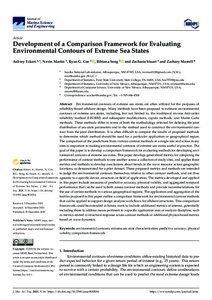| dc.contributor.author | Eckert, Aubrey | |
| dc.contributor.author | Martin, Nevin | |
| dc.contributor.author | Coe, Ryan G. | |
| dc.contributor.author | Seng, Bibiana | |
| dc.contributor.author | Stuart, Zacharia | |
| dc.contributor.author | Morrell, Zachary | |
| dc.date.accessioned | 2021-04-06T23:50:03Z | |
| dc.date.available | 2021-04-06T23:50:03Z | |
| dc.date.issued | 2021 | |
| dc.identifier.citation | Eckert, A.; Martin, N.; Coe,
R.G.; Seng, B.; Stuart, Z.; Morrell, Z. (2021)
Development of a Comparison Framework
for Evaluating Environmental Contours
of Extreme Sea States. Journal of Marine Science and Engineering, 9:16, 24pp. DOI: https://dx.doi.org/
10.3390/jmse9010016 | en_US |
| dc.identifier.uri | http://hdl.handle.net/11329/1539 | |
| dc.identifier.uri | http://dx.doi.org/10.25607/OBP-1035 | |
| dc.description.abstract | Environmental contours of extreme sea states are often utilized for the purposes of
reliability-based offshore design. Many methods have been proposed to estimate environmental
contours of extreme sea states, including, but not limited to, the traditional inverse first-order
reliability method (I-FORM) and subsequent modifications, copula methods, and Monte Carlo
methods. These methods differ in terms of both the methodology selected for defining the joint
distribution of sea state parameters and in the method used to construct the environmental contour
from the joint distribution. It is often difficult to compare the results of proposed methods
to determine which method should be used for a particular application or geographical region.
The comparison of the predictions from various contour methods at a single site and across many
sites is important to making environmental contours of extreme sea states useful in practice. The
goal of this paper is to develop a comparison framework for evaluating methods for developing environmental
contours of extreme sea states. This paper develops generalized metrics for comparing the
performance of contour methods to one another across a collection of study sites, and applies these
metrics and methods to develop conclusions about trends in the wave resource across geographic
locations, as demonstrated for a pilot dataset. These proposed metrics and methods are intended
to judge the environmental contours themselves relative to other contour methods, and are thus
agnostic to a specific device, structure, or field of application. The metrics developed and applied
in this paper include measures of predictive accuracy, physical validity, and aggregated temporal
performance that can be used to both assess contour methods and provide recommendations for
the use of certain methods in various geographical regions. The application and aggregation of the
metrics proposed in this paper outline a comparison framework for environmental contour methods
that can be applied to support design analysis workflows for offshore structures. This comparison
framework could be extended in future work to include additional metrics of interest, potentially
including those to address issues pertinent to a specific application area or analysis discipline, such
as metrics related to structural response across contour methods or additional physics-based metrics
based on wave dynamics. | en_US |
| dc.language.iso | en | en_US |
| dc.rights | Attribution 4.0 International | * |
| dc.rights.uri | http://creativecommons.org/licenses/by/4.0/ | * |
| dc.title | Development of a Comparison Framework for Evaluating Environmental Contours of Extreme Sea States. | en_US |
| dc.type | Journal Contribution | en_US |
| dc.description.refereed | Refereed | en_US |
| dc.format.pagerange | 24pp. | en_US |
| dc.identifier.doi | https://dx.doi.org/ 10.3390/jmse9010016 | |
| dc.subject.parameterDiscipline | Parameter Discipline::Physical oceanography::Waves | en_US |
| dc.bibliographicCitation.title | Journal of Marine Science and Engineering | en_US |
| dc.bibliographicCitation.volume | 9 | en_US |
| dc.bibliographicCitation.issue | Article 16 | en_US |
| dc.description.sdg | 14 | en_US |
| dc.description.eov | Sea state | en_US |
| dc.description.maturitylevel | TRL 8 Actual system completed and "mission qualified" through test and demonstration in an operational environment (ground or space) | en_US |
| dc.description.bptype | Manual (incl. handbook, guide, cookbook etc) | en_US |
| obps.contact.contactname | Aubrey Eckert | |
| obps.contact.contactemail | acecker@sandia.gov | |
| obps.resourceurl.publisher | https://www.mdpi.com/2077-1312/9/1/16 | en_US |
 Repository of community practices in Ocean Research, Applications and Data/Information Management
Repository of community practices in Ocean Research, Applications and Data/Information Management

